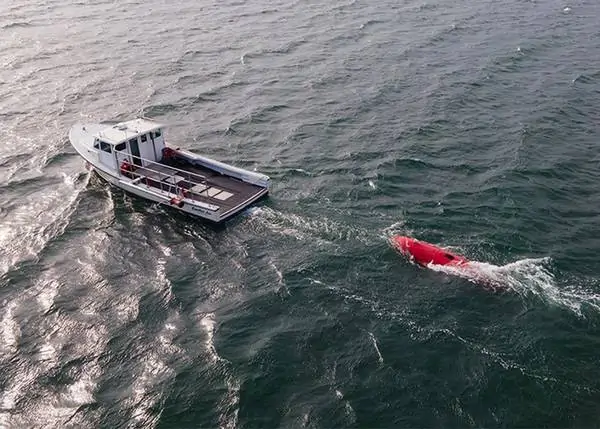Sonardyne navigation, tracking and control technologies have been selected by underwater robotics developer Dive Technologies for its large displacement DIVE-LD autonomous underwater vehicle (AUV) programme. The DIVE-LD AUV is a long-endurance platform that is being developed to meet the needs of a variety of mission types in the commercial, research and defence sectors.
The DIVE-LD AUV, measuring 48 inches in diameter and 19 feet long and designed for operations at depths of up to 6000 m, is currently in production in the US, with sea testing ongoing in New Bedford, Massachusetts. System development has focused on selecting high-performance, off-the-shelf systems, thus allowing the company to focus their efforts on building other particular customized systems in-house.
Dive Technologies selected Sonardyne’s SPRINT-Nav hybrid navigation system to provide long-distance and long-duration navigation with a minimum of complexity and payload space consumption. The system, which is available in a variety of performance levels all in the same form factor, supports the company’s focus on mission adaptability, as does the Ranger 2 Ultra-Short BaseLine (USBL) system, which features a the state-of-the-art compact Gyro USBL. The Ranger 2 will provide tracking and communication during development and testing.
The DIVE-LD AUV has also been fitted with Sonardyne’s AvTrak 6 – a combined transponder, modem and emergency relocator beacon.
Tim Raymond, Dive Technologies’ Director of Research and Development, commented that Ranger 2 offered a proven platform with a track record across a wide range of use cases, offering flexibility and scalability in functionality and complexity: “With a new development effort underway for Dive Technologies’ DIVE-LD autonomous underwater vehicle, we had a wide range of use cases in mind and needed a single system capable of supporting the various mission sets we had in mind. We also needed a topside system which could scale in functionality and complexity with our vehicle as we continue to add features and capabilities, from our initial testing where our needs were just tracking and emergency commands, to more advanced features such as USBL aiding and SMS transmission of vehicle and data health metrics.”
“Ranger 2 is a good fit for both of these needs and it has enabled us to meet our challenging goals of simultaneous development and testing while maintaining consistent and impressive performance even in challenging operating conditions. The system has proven reliable, easy to use, and portable to support mobilisation on a variety of support vessels.”
Dive Technologies’ rapid development program has included support from the Defense Advanced Research Projects Agency (DARPA) and technology partnerships with organizations including the Center for Marine Autonomy and Robotics at Virginia Tech.











